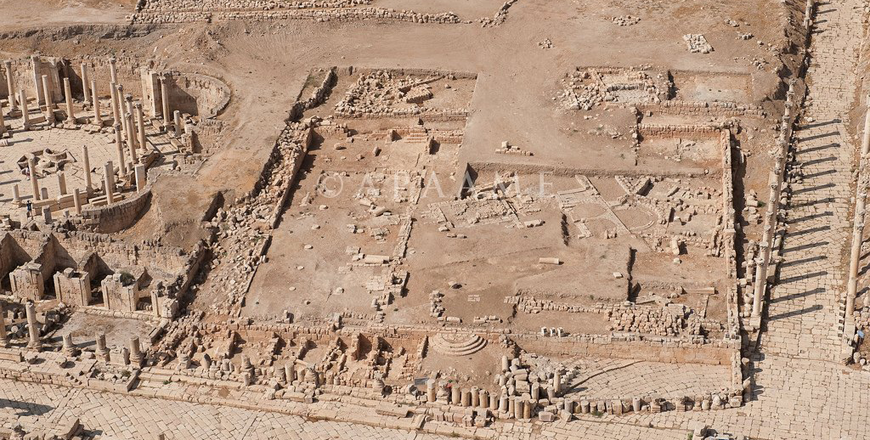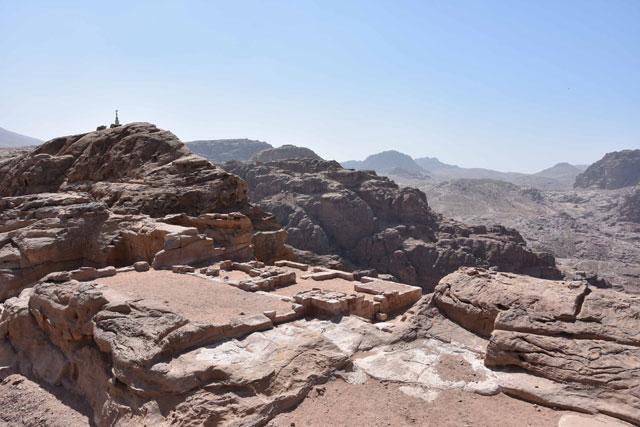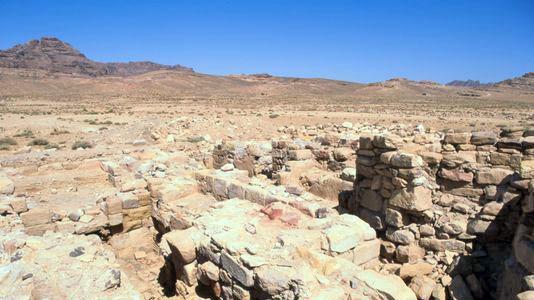You are here
Central bathhouse of Gerasa: Focusing on bathing culture from Late Roman to Umayyad period
By Saeb Rawashdeh - Jul 01,2024 - Last updated at Jul 01,2024

Aerial view of the Southern Theatre, Oval Piazza and Temple of Zeus (Photo courtesy of ACOR)
AMMAN — During the Late Roman, Byzantine and Umayyad times, Gerasa (modern Jerash) was famous for its bathhouses.
This time, we are going to focus on the Central Bathhouse that is located in the commercial hub, in the south-western corner of the intersection of Jerash’s axial street and the south transverse street.
The excavation of the bathhouse started in 1998 by the Department of Antiquities and the numismatic and ceramic finds date the construction of the bathhouse to the late 3rd or early 4th centuries AD and suggest that it was dismantled in the early 8th century AD during the reorganisation of the area for the construction of a congregational mosque.
“The bathhouse comprises several integrated architectural components. The bathing suite is flanked to the north by shops, two changing rooms [apodyteria], and a latrine, and to the south by a service area. One entrance provided access to the baths from the south transverse street, while another led from an alley that ran perpendicular to the south transverse street to the west of the bathhouse,” noted Luise Blanke, a senior lecturer from The University of Edinburgh.
The second entrance opened onto a hall with two doorways: one leading south to a changing room and One leading east to the latrines, Blanke said, adding that this spatial arrangement would have secured independent opening hours and perhaps also allowed visitors to use the latrines without paying a fee to enter the bathhouse. The bathing suite is laid out with the unheated section (frigidarium) to the north and the heated sections (tepidarium and caldarium) to the south.
“The frigidarium consists of a single room with two semi-circular basins. The heated section contains four rooms, with a single furnace placed in the south end and chimneys in the north end to direct the hot air through a complex hypocaust system, Blanke elaborated, adding that during its lifespan, the Central Bathhouse underwent several architectural modifications.
The most significant was the gradual reduction in the size of the heated area, which was accompanied by the abandonment of communal bathing for the privacy of smaller individual bathtubs, of which three were preserved in the heated section, she said.
“The function of the heated section gradually changed, and the hypocaust rooms became superfluous. Towards the end of the building’s history, only a single heated room remained in use; and finally, the hypocaust in the last remaining heated room was filled in, refloored and used for other purposes,” Blanke underlined.
Situated to the north of the bathing suite, the latrine remained in use throughout the life of the bathhouse, she continued, adding that it consists of a semi-circular room, with a sewer that runs along the entire length of the curved north wall. No remains of seating were found, but a ledge in the wall above the sewer indicates where the seating would have been.
“A shallow channel runs in front of the seating, from the southwest corner of the room and disappears into the sewer in the southeast corner. This channel would have provided a constant clean water supply. Although it has not been possible to estimate the number of people who could have used the bathhouse during a single day, calculations published elsewhere suggest that the multiseater latrine could have been frequented by more than 600 users during a 12-hour window,” Blanke elaborated.
The assemblage of finds discussed here was largely deposited towards the end of the bathhouse’s use and dates to the late 6th and 7th centuries AD, with a few residual specimens dating to the 4th or 5th century AD.
“We argue that although the bathhouse underwent major architectural alterations during its lifespan, the activities that took place within the building remained largely unchanged. Our study shows that bodily grooming remained integral to the bathing experience, while food and drink were consumed on the premises even when the bathing facilities were reduced to a bare minimum,” Blanke underlined, adding that the faunal remains indicate the types of food consumed, while the small finds illustrate a lively environment of gaming and perhaps also gambling in a social space frequented by men, women and children.
Related Articles
AMMAN — Built in the late 3rd or early 4th century AD, the Central Bathhouse in Gerasa (modern Jerash) was in use for another 300 year
AMMAN — Until now, very little was known about public baths in Petra, according to a French architect affiliated with Ifpo who developed a r
AMMAN — The early adaption of an ancient heating system by the Nabataeans point to an outward-facing society, according to a Canadian archae














